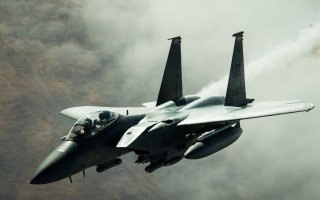Fact: The F-15 Almost Joined the U.S. Navy
Had events worked out differently, the aircraft that Tom Cruise flew in Top Gun could have been an F-15 Eagle.
Key Point: The Air Force and Navy will only buy each other's aircraft if the politicians force them to do so.
Back in the 1980s and 1990s, a Dynamic Duo symbolized U.S. military airpower. The Air Force had its powerful F-15 Eagle air superiority fighter. But the Navy had the sophisticated swing-wing F-14 Tomcat, glamorized by the movie Top Gun.
Yet had events worked out differently, the aircraft that Tom Cruise flew could have been an… F-15 Eagle?
For a time, the Navy actually considered a carrier version of the F-15. The F-15N, or "Sea Eagle" as it was unofficially dubbed, was proposed by McDonnell Douglas in 1971, according to author Dennis Jenkins in his "McDonnell Douglas F-15 Eagle: Supreme Heavy-Weight Fighter."
The Sea Eagle would require some modifications, such as folding wings and stronger landing gear. But McDonnell Douglas's position was that "due to its excellent thrust-to-weight ratio and good visibility, the F-15 could easily be adapted for carrier operations," Jenkins writes.
For a sketch of what the Sea Eagle might have looked like, go here.
The early 1970s were an opportune time for McDonnell Douglas (now part of Boeing) to make its pitch. The F-14, first deployed in 1974, was under fire because of the troublesome and underpowered Pratt & Whitney TF30 engines initially fitted to the fighter. Nor did the price tag help: An F-14 cost $38 million in 1998 dollars, versus $28 million for the Air Force's F-15A.
The F-15N would probably have been faster and more maneuverable than the F-14, as well as cheaper. But the carrier modifications would have rendered the Sea Eagle 3,000 pounds heavier than the land-based version. Perhaps more important, the initial F-15N design was only armed with Sidewinder and Sparrow air-to-air missiles as well as a cannon. What it didn't have was the long-range AIM-54 Phoenix missile that the Navy counted on to stop Soviet bombers well before they could attack the fleet.
A Navy fighter study came up with another tack: an F-15 armed with Phoenix missiles and their associated long-range AN/AWG-9 radar. But the Phoenix Eagle would have weighed 10,000 pounds more than the F-15A, which meant that it wouldn't have offered any performance advantage over the Tomcat. McDonnell Douglas and Phoenix manufacturer Hughes countered with the F-15(N-PHX), which kept the Phoenix missiles but ditched the AN/AWG-9 radar for an enhanced version of the AN/APG-63 radar on the Air Force F-15A.
A Senate subcommittee began examining the naval F-15 in March 1973. "At this point the F-14 program was having difficulties, and the subcommittee wanted to look at possible alternatives, namely lower-cost (stripped) F-14s, F-15Ns, and improved F-4s," Jenkins writes. "There were even proposals by Senator Eagleton for a ‘fly-off’ between the F-14 and F-15, but this never transpired."
In the end, the Navy stuck with the Tomcat. But something did come out of the Sea Eagle project. The Senate hearings, "along with some other considerations, led to the forming of Navy Fighter Study Group IV, out of which the aircraft ultimately known as the F/A-18A was born," Jenkins writes.
Was the Sea Eagle a viable concept? The problem is the one that we are seeing with today's F-35: an aircraft that must serve more than one master inevitably sacrifices performance in some area (in fact, the F-14 was born after the Pentagon's abortive attempt to make the ill-fated F-111 a joint Air Force and navy fighter). To turn the F-15 into a carrier-based interceptor like the F-14 would have required so many design changes that the hybrid beast would probably have been inferior to either the F-15 or F-14.
Which points to the real problem: The Air Force and Navy have always had different requirements. In the 1970s, the Air Force wanted a powerful, highly maneuverable dogfighter to prevent a repeat of what happened when its F-4 Phantoms battled more nimble MiGs over Vietnam. Though ironically, the Air Force did at one point consider the F-14 as a replacement for the F-106 interceptor.
But the Navy needed an interceptor that could stop Soviet bombers and anti-ship missiles. This meant an aircraft with a high-powered radar as well as big, long-range air-to-air missiles. Like the F-35, attempting to use the same platform for dissimilar missions means a circle so squared that it becomes unrecognizable.
And of course, there was politics. The Air Force and Navy will only buy each other's aircraft if the politicians force them to do so. The Sea Eagle was probably not a good idea to begin with, but it certainly was doomed without a powerful backer in the Pentagon or White House.
Fortunately, in the end, the Air Force and the Navy got the fighters they wanted. Just not the same fighters.
Michael Peck is a contributing writer for the National Interest. He can be found on Twitter and Facebook. This article was first published several years ago.
Image: U.S. Air Force / Flickr

